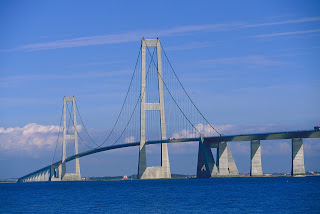The Great Belt Fixed Link is a multi-element fixed link crossing the Great Belt strait between the Danish islands of Zealand and Funen. It consists of a road suspension bridge and a railway tunnel between Zealand and the small island Sprogø in the middle of the Great Belt, and a box-girder bridge for both road and rail traffic between Sprogø and Funen. The total length is 18 kilometres (11 mi).
The "Great Belt Bridge" commonly refers to the suspension bridge, although it may also be used to mean the box-girder bridge or the link in its entirety. Officially named the East Bridge, the suspension bridge was designed by the Danish firms COWI and Ramboll. It has the world's fifth-longest main span (1.6 km (1 mi)), and the longest outside Asia. At the time of the opening of the bridge it was the second longest, beaten by the Akashi Kaikyō Bridge opened a few months previously.
The link replaced a ferry service, which had been the primary means of crossing the Great Belt. After more than 50 years of debate, the Danish government decided in 1986 to construct a link; it opened to rail traffic in 1997 and to road traffic in 1998. At an estimated cost of DKK 21.4 billion (1988 prices), the link is the largest construction project in Danish history. It has reduced travel times significantly; previously taking one hour by ferry, the Great Belt can now be crossed in ten minutes. This link and the Øresund Bridge (built 1995–1999) have together enabled driving from mainland Europe to Sweden and the rest of Scandinavia through Denmark.
Operation and maintenance are performed by A/S Storebælt under Sund & Bælt. Construction and maintenance are financed by tolls on vehicles and trains. Cyclists are not permitted to use the bridge, but bicycles may be transported by train or bus. More details


No comments:
Post a Comment